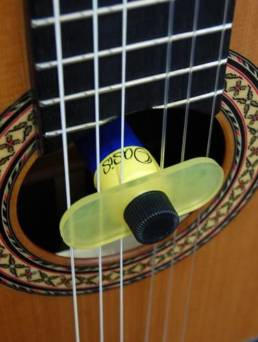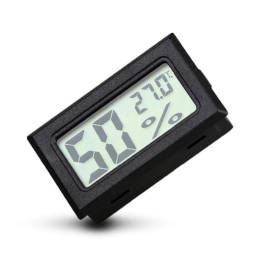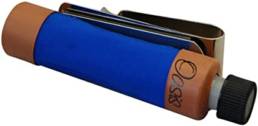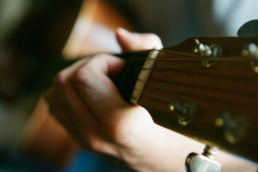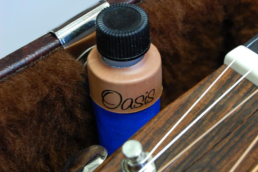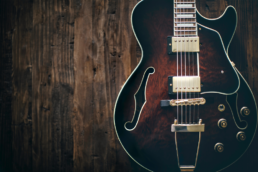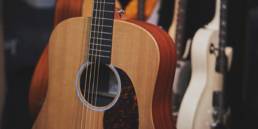WHY USING A GUITAR HUMIDIFIER IS IMPORTANT
You probably already know how integral using a guitar humidifier is for the maintenance and longevity of your guitar. So vital is this basic (yet often overlooked) step, it almost goes without saying that it is absolutely imperative to begin effectively humidifying your instrument in order to protect your investment…. (but here we both are, so it bears repeating!).
Without proper humidification, it is simply a matter of time before you experience one of a host of problems that will need to be addressed, ranging from minor to severe – all adversely affecting the playability of your guitar.
A dried out guitar may express some or all of the following conditions:
-
- Fret buzz. Likely due to low action as strings are too close to the fretboard.
- Shrinkage of the fingerboard. Often resulting in fret ends that are proud and feel sharp.
- A split or sunken soundboard. Typically evidenced between the fingerboard and the bridge.
- Bridge separation. As different wood species shrink at different rates, bridges can start to lift and / or separate from the soundboard.
- Releasing of braces. Structural soundboard and back braces release.
- The dreaded ‘Hump’. Seen on many acoustics at the neck-to-body connect.
The above is a short-list of some of the problems I see in my shop when a guitar has dried out. When these problems are so easily mitigated, why then do so many musicians and collectors that I talk with remain in the dark when it comes to proper guitar humidification and the use of a simple guitar humidifier?
Maybe because, unless you’ve experienced obvious and clear-cut structural issues with your guitar, preventative maintenance may seem uninteresting, time consuming or even irrelevant. After all, the insidious nature of improper humidification tends not to manifest to any significant degree until, well… until it does.
Okay, the time for excuses is over and this guide is here to help you understand why using a guitar humidifier is absolutely vital if you care about your strung-up ‘pride-and-joy’. In this post, I’ll cover how to properly humidify your guitar (or bass, ukulele, etc.) as well as provide helpful resources to support the ‘general maintenance’ of your instrument.
Alright – here are the topics we’ll cover. Feel free to click a heading if you just want to quickly jump to the goods; otherwise, grab a coffee, relax and read on!
-
What is Relative Humidity?
-
What is the Ideal Humidity Level for Guitars?
-
Why Using a Guitar Humidifier is Important
-
How do we Measure and Address Humidity Levels?
-
How do we know when Humidity Levels have been Restored?
-
What other Maintenance Items Should be Considered?
Let's get started with one important question...
While humidity can be measured in a number of ways ranging from ‘absolute’, ‘relative’ and ‘specific’, ‘relative humidity’ (RH) is the most common measure we’ll reference in the scope of guitar humidification.
In simple terms, ‘relative humidity’ (RH) describes the amount of water vapour that exists in the air compared to the maximum amount that could be held at a given temperature. 50% RH, for example, means that the air is holding 50%, or one-half of the potential water it could hold.
While the concept of 0% relative humidity (air devoid of water vapour) is not truly possible on Earth due to minute amounts of water vapour always existing, it helps illustrate a reference point when contrasted to when 100% RH is reached, also known as ‘dew point’. Simply put, dew point is met when the air can no longer hold any more water in the form of a gas and water droplets form.
OK - Enough technical stuff... How does this apply to my guitar?
Simply put, wood is hygroscopic. This means that it is a material that will absorb water will try to equalize to it’s surrounding air, in both temperature and humidity. If wood becomes too moist it will swell; on the other hand, if wood gives up it’s moisture, it will shrink. While an over-humidified guitar is possible and will create its own set of unique problems, an under-humidified or ‘dry’ guitar is far more common.
"No environmental condition can do more damage to your instrument than low relative humidity (RH)."
-Taylor Guitars

An Easy Rule… If you’re Happy, your Guitar is Happy!
Believe it or not, both humans and instruments are both the most comfortable at 45-55 percent relative humidity. Based on my layman’s narrative of relative humidity above, this mid-point is an easy target to remember; in short, half-way between the driest of dry you can imagine (0% RH) and to the point where moisture begins to form and accumulate (100% RH).
As a case in point, in the winter months here in the Okanagan Valley, which is a desert in the interior region of BC, Canada, our home and my workshop will see winter humidity levels hover around 25-28% RH. At these conditions, cupboards warp and don’t close properly, wooden doors begin to stick, wood floors ‘gap’, my family complains of dry skin and dry eyes and my guitars can start to express signs and symptoms of dryness ranging from sharp frets to fret buzzing in the most modest of cases.
To illustrate this point, sharp frets indicate that wood shrinkage has occurred as the metal frets don’t change due to environmental factors, however, the fretboard wood (ebony, rosewood, etc.), does. Other indicators are frets lifting, especially near the fret ends.
Geography Affects Humidity… in Part.
Many areas in North America experience naturally low humidity all year long. Canadian regions include the city of Osoyoos atop the list in the Okanagan Valley as well as Alberta being of the driest regions in the country. Phoenix and Las Vegas follow suit when we look state-side. However, low RH levels accompany the onslaught of winter in many parts of the world, mainly due to the effects of artificially heating our homes and commercial spaces. My point here is to not let your geography fool you into thinking the RH is adequate.
A Personal Anecdote
I made this error when borrowing a guitar during the winter for a week from a friend on the West Coast of BC on Vancouver Island. With the amount of annual precipitation, I simply assumed the humidity in my suite was in check. Upon returning the guitar, he complained of fret buzz and the instrument sounding flat with a noticeable reduction in the soundboard arch.
Much to my embarrassment, post-purchase of an affordable hygrometer revealed that my suite was hovering at 28% RH – again, baseboard heaters were the culprit. A room humidifier corrected my home environment to a constant 45% after running continuously for about a week and a guitar case humidifier corrected the guitar issues in about the same amount of time. Needless to say, I felt terrible but it was the impetus for me to take humidification more seriously.
A Note on Owning A Whitney Guitar
Further to this point, all of the woods I use for guitar construction here at Whitney Guitars are stored in a controlled environment of 45% RH and a temperature of 21-23 degrees Celsius. This consistency in my shop allows for woods to equalize to an ideal moisture content for guitar building.
It is important to note that even with all these factors controlled at this ‘median’ humidity level, wood is still wood. While equalized and set-up for the best success, significant humidity changes can still cause woods to incur shrinking and expansion. As such, I always include notes on this within the warranty documentation for my instruments.
Don't Let this Happen to You! :)
The image below shows a Gibson 12-string that came in the shop after being left in a hot car. The owner heard an audible ‘bang’ and discovered the bridge had essentially sheared off of the soundboard. Stress cracks are also evident, common to the bridge compromise, lack of humidity or both. The guitar has since been restored with a new soundboard and bridge and is once again enjoying her life.
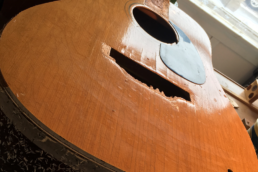
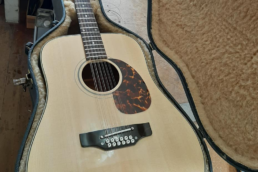
As colder winter temperatures lend themselves to a ‘cranking up’ of indoor temperature, we often fail to realize that in-turn, we’re driving humidity levels down even lower. I mentioned previously that without corrective measures in place, the RH levels in my workshop and home hover between 25-28% RH in the winter. Sadly, at anything less than ~45% RH we’re simply drying out our instruments and run the risk of cracking as well as structural and cosmetic damage.
In short, both reading and correcting humidity levels with the use of a hygrometer and humidifier just makes sense and affords peace of mind in view of otherwise unnecessary damage and costly repairs.
A dried out guitar can see a weight increase of 25 grams of water when properly humidified!

The Digital Hygrometer
The first step, of course, is to be able to quantify where your humidity levels are at. This can be easily accomplished with the use of a hygrometer. If you’ve not heard that term before, a hygrometer is to humidity what a thermometer is to temperature. In short, a hygrometer gives us a reading as a percentage of the humidity in a given environment.
Personally, I prefer the digital type for better accuracy and I keep one in any room that I keep my guitars, tone-woods for building, and also in my shop where I build, repair and restore guitars. It can also be easily tucked into any guitar (or bass, ukulele, etc.) case to monitor the internal environment both before and after adding a humidifier.
The 'Whole Home' Option
I initially opted for a ‘Desert Springs’ humidifier back in 2009, which mounts to the furnace thereby improving humidity levels through the home ducting and floor registers. I chose the ‘AutoFlush’ system as it refreshes the water reservoir automatically.
Our unit has been running strong for over a decade, was simple to install, and gives me the peace of mind that the indoor conditions in our home are now stable. In addition, customer support has been exceptional.
While storing my guitars in the case adds an extra ‘barrier to entry’ and I find that I tend to play less, the ‘whole home’ unit protects all of the wood in my home, adds to our overall comfort here as a family, and gives me the peace of mind that my guitars are protected when I do leave them out in the guitar stand.
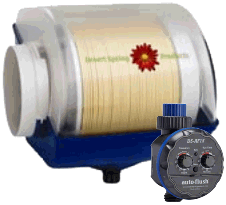
Oasis Guitar Case Humidifiers
Alright… with humidity levels established using the discussed hygrometer, we can now effectively work to correct humidity levels into a safe range of 45-55% by the use of the following:
- Guitar Case Humidifier: Such as the ‘Oasis’ models OH-1 or OH-6.
- ‘Whole Home’ Furnace Humidifier: Such as the ‘Desert Springs’ model DS-3200-M with AutoFlush.
In short, the Oasis guitar case humidifier is a compact, leak-proof and affordable way to bring proper humidity levels to your instruments. It tucks neatly into either the sound-hole or attaches to the inside of your case and required little maintenance apart from ensuring there is enough water in the sleeve. I recommend checking it about once per week to insure the ‘Humigel’ crystals are saturated. It really is a ‘set and forget’ solution, for the most part.
What I Do
While my guitar inventory continues to build, keeping guitars stored safely in their respective cases has become even more important. For this reason, I now keep a case humidifier in every guitar case in my showroom as well as in the cases of guitars that I ship to my clients.
In addition, I have the Desert Spring furnace unit to control my home environment. While I understand this option may not be suitable for everyone, I would, at the very least, invest in a simple guitar-case humidifier as I mentioned earlier. There are a number being offered such as the ‘Planet Waves’ unit from D’Addario as well as some pretty basic ones from Chinese vendors on Amazon and Alibaba. While I can’t speak to the quality of the latter, my favourite by far is from Dave Hepple, who owns ‘Oasis Guitar Humidifiers’ in Maryland, USA.
The OH-1 and OH-6 are Oasis’ best-sellers by far. The key difference is that the OH-1 rests within the strings of an acoustic guitar by way of a soft silicone insert and the OH-6 comes with a clip to attach to the side of the guitar case. Both units are leak-proof, come with the required ‘Humigel’ for retaining water within the unit as well as a 10cc syringe to refill the humidifier as needed.
To sum this all up, if you suspect that a guitar that has dried out, it’s best to return the instrument to a hardshell case with a humidifier of your choosing such as the Oasis OH-1 or OH-6. A gig-bag or soft-shell case will work as well but will not be as efficient in terms of retaining humidity as will a hard-shell case. This is not a problem but may mean you’re recharging your humidifier more often.
I recommend leaving the guitar for 4-7 days and and check the humidifier periodically to ensure it is still charged. ‘Charging’ refers to adding additional water when necessary so that humidity remains constant. Don’t forget to monitor with a digital hygrometer.
Upon successful re-humidification, your guitar should exhibit a correction as follows:
- Improved action. Strings are no longer very close to the fretboard.
- Restored arches in the soundboard and back plate begin to be restored.
- Neck correction (to a lesser degree).
- Correction to sharp fret ends although frets may still remain proud and need to be dressed.
Changing Strings Regularly
While there is no string-change schedule that is set in stone, I generally recommend changing strings every three months with modest playing. One hundred hours accounts for roughly an hour per day of playing and is a good rule-of-thumb to go by. More playing, heavy gigging and so forth may demand string changes every month.
Some tell-tale signs that your strings are toast can be measured by a dullness in sound and lack of tone, discolouration, fret wear or grooves on the underside of your strings. Sweat, dirt, individual acidity levels and environmental factors can all adversely affect your strings, and consequently, your playing and ability to optimize the music you make with your instrument.
Changing strings is an affordable and easy ‘upgrade’ to your guitar. Consider doing it frequently.
Keeping your Guitar Clean and Oiled
Invariably, oil from your skin and dirt is going to find it’s way to your strings and fretboard. Salt from your skin and individual acidity levels can also start to eat away at fretboards. Ever seen those deep divots in fingerboards, generally in first position and after years of playing? Believe it or not, that is less likely due to string and / or finger friction as it is to salt deteriorating the wood itself (think of a wooden ship in the ocean exposed to salt for years).
While changing your strings, it’s a good time to remove all of the ‘gak’ (technical term) from your frets and fretboard and oil up those ebony and rosewood boards with a lemon oil or a tung oil. This will hydrate those playing surfaces and keep your guitar happy for many years.
I recommend using fine steel wool to clean ebony, rosewood and pau ferro boards and a soft damp cloth for maple boards. When oiling your ‘non-maple’ fretboard (it’s not necessary to oil maple), a little oil goes a long way, so there’s no need to saturate things; rub it in well, let it sit for five-to-ten minutes and wipe off the excess before re-stringing.
Truss Rod Adjustments
While a detailed conversation on truss rod adjustments is beyond the scope of this post, suffice to say that if you need to add relief to the guitar neck, you’ll want to loosen the truss rod or turn the truss rod nut counter-clockwise. To reduce the amount of relief you’ll want to tighten the truss rod or turn the truss rod nut clockwise. Be careful here; a quarter turn can do a lot and a truss rod adjustment should never be used to correct action alone or an instrument in need of fret work. If you are strictly correcting the effects of humidity or lack thereof, a truss rod adjustment may be considered.
Remember – if in doubt, take it to a pro!
Annual Setups & Tune-ups
Much like a tune-up on your vehicle or a cleaning at the dentist, I recommend annual setups / tuneups of your ‘axe’. Guitars coming out of the showroom are usually production run and fine-tuning often isn’t in the budget. Guitars are sent out ‘playable’ and setup within a very safe spec range, often to account for any shifting or changing due to environmental changes and so forth.
To my point, I’ve had brand new, high-end US Strats on the bench with uneven frets, poorly set pickup height, and high action. This can sometimes extinguish the ‘wow’ factor when owning a new instrument as the potential of that guitar is not being fully realized. A proper setup can breathe new life into instruments both new and old.
A tune-up is more like that annual checkup. If things have shifted due to environmental changes or if adjustments need to be made, a luthier or repair tech can address those issues as well as cleaning up and polishing the frets and fretboard, among numerous other items that will rekindle your love for your guitar.
Simply put, don’t let the ‘general maintenance’ go unchecked!
ENJOY THIS POST ON THE IMPORTANCE OF GUITAR HUMIDIFICATION?
Sign up to our newsletter to receive updates on new guitar builds, new blog posts, upcoming guitar building courses, and more…
Michael Whitney
Michael Whitney is a luthier specializing in fine, handmade, Gypsy Jazz guitars in the Selmer-Maccaferri tradition. From his studio in Summerland, BC, Canada he creates fine stringed-instruments on a commission basis and also teaches the art of luthiery to aspiring luthiers and hobbyists, alike.
Related Posts
June 15, 2021
Gypsy Jazz Guitar Modèle Vagabond ‘Grande Bouche’ No. 14
This commission came by way of Jim…
November 3, 2019
Guitars for Veterans – Learn the Art of Building and Giving
'Guitars for Vets' (military veterans…

